Bunion Surgery Recovery Time
Posted July 15, 2024 in Bunion Surgery, Bunion Surgery Recovery

Bunion surgery is crucial for patients with moderate to severe bunions, but it doesn’t have to throw a wrench in your schedule. This blog discusses how long patients can expect limited mobility during their bunion recovery and provides a brief timeline of expected recovery milestones.
4 Min Read:
Don’t Stress–Plan Your Recovery Ahead of Time
While foot surgery is rarely a thrilling prospect, living with debilitating bunions is a much worse one. If you’re preparing for bunion surgery, even while looking forward to relief from pain, you most likely want to know how long you’ll be off your feet. While everyone is different, having a general timeline can help you plan what you’ll need to make your recovery a breeze.
How Long Does Bunion Surgery Recovery Take?
While each patient is different, it generally takes about six weeks to recover from bunion surgery. But, while the initial recovery and downtime may only take about a month, other gradual improvements and healing milestones can make moving around much easier.
Bunion Recovery Timeline
Day One: Bunion surgery is an outpatient procedure, so you will be able to return home the same day. Your foot will be wrapped in gauze or protective padding, and you may be given a surgical boot. Some patients will be able to use the surgical boot to walk relatively comfortably right away; others may need crutches, a scooter, or a walker.
Your surgeon will send you home with the appropriate supplies, including prescription pain medication, if necessary. Make sure you have reliable transportation arrangements made since you should not drive yourself or walk very far.
Week One: In your first week of recovery, you will need to prioritize rest as much as possible. Your surgeon will most likely instruct you to:
- Avoid putting unnecessary weight on your big toe
- Elevate your foot to reduce swelling
- Keep your wound and bandages clean and dry
You will not need to change your dressings or mind your incisions in the first week; all you have to do is keep your surgical site clean, dry, and protected. The main priority for recovering patients should be to get plenty of rest, which will help aid in the healing process as much as possible.
Surgeons recommend that in the first week of bunion surgery recovery, patients try to keep their feet elevated for 55 minutes out of every hour. Patients find it helpful to use pillows or cushions to elevate their feet when resting on the couch, in bed, and whenever possible.
Week Two: The emphasis will still be on elevating your foot, keeping your wound clean and dry, and resting as much as possible. Depending on the specifics of your procedure, you may be asked to return to your podiatrist to remove sutures or for an examination.
Many patients will be able to return to work at this time, especially for those who sit for most of the day. For patients who work on their feet, usually, 7 to 10 days is sufficient healing time to be able to return to a modified standing work schedule.
As you start to become more mobile, around the house, or returning to work, pain management will become more important. Most patients will be fine with over-the-counter medications, as well as taking frequent breaks to elevate their recovering foot and using ice packs.
Weeks Three and Four: You should be fully cleared to return to work, even if you stand for much of your day. While gradually increasing your activity levels is important for promoting healthy blood circulation, be sure to listen to your body and avoid putting too much pressure on your foot.
Your pain should be minimal at this point, so you will be able to adjust your pain management process.
Week Five and Beyond: After about one month, bunion surgery recovery comes down to the natural healing process of the patient, the nature of their specific surgery, and their ability to practice diligent aftercare. You may still be managing some discomfort after being on your feet too long, some persistent swelling, and you may still get fatigued from standing or walking too long.
Your podiatrist may start you on a physical therapy regimen to help your joints, muscles, and tendons get back to normal function. Usually, these exercises focus on strengthening the foot and restoring a normal range of motion and flexibility.
Want to Learn More About Bunion Surgery Recovery Tips in NYC?
If you think you have a bunion or you’re looking for bunion care in New York City, call Chelsea Foot & Ankle today at (646) 929-4149 or fill out our contact form to get started. Our bunion specialists are ready to help determine diagnostics, advise on conservative bunion care, and assess your eligibility for surgery.
